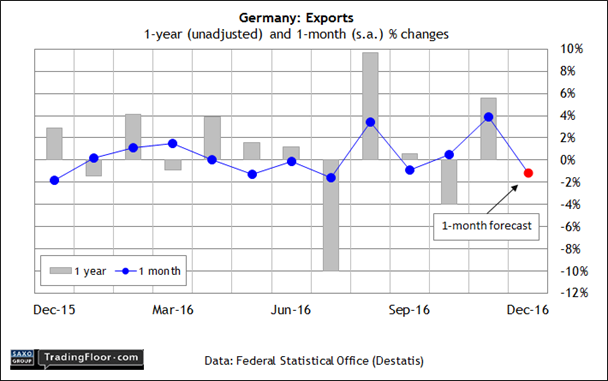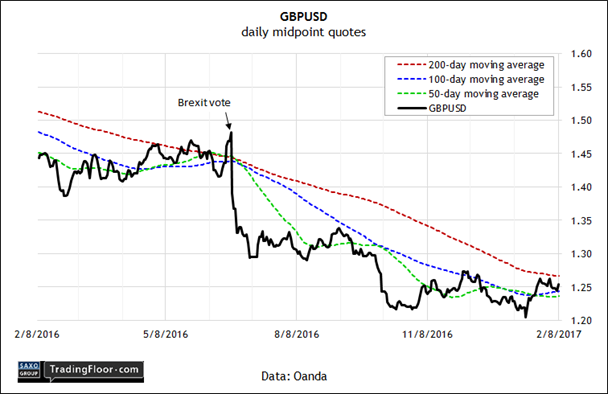- German exports in December are on track to fall for the first time in three months
- U.S. jobless claims should stick close to a 44-year low in today's weekly release
- The Brexit-triggered decline in the pound may have already run its course
- The UK will need strong links with emerging economies following its EU exit
Exports in Europe’s largest economy are in focus today with the release of Germany’s merchandise trade report for December. Later, the weekly update on U.S. jobless claims hits the streets. Meantime, keep an eye on GBP/USD, which appears to be stabilizing after sliding for months in the wake of last June's Brexit vote.
Germany: Merchandise Trade Report (0700 GMT): Europe’s biggest economy had a record year in 2016 for exports, according to preliminary estimates from the Ifo Institute. Germany sold nearly $300 billion more in goods and services to countries than it imported. But with anti-globalisation forces on the rise, the outlook for a repeat performance in 2017 and beyond has turned cloudy.
The election of Donald Trump, who favours a protectionist agenda, as U.S. president could pinch German export growth this year, the head of Germany’s BGA trade and wholesale association said this week. Anton Boerner advised:
There is much as stake for us due to the close economic links between our country and the United States.
But in the wake of the recent shift in priorities in Washington, a “big question mark” hangs over the outlook for German exports in the months and perhaps years ahead, he warned.
Despite the uncertainty, German exporters remain optimistic. Ifo’s index of export expectations rose in January, close to the highest level in two years. “The German economy currently seems unfazed by the protectionist rhetoric of the new U.S. President,” noted the president of the think tank.
Meanwhile, Germany's DIHK Chambers of Commerce lifted its estimate for the country’s growth rate this year to 1.6%, supported by a solid increase in projected exports for 2017.
Today’s update for December, however, is expected to show a 1.1% decline for exports, the first monthly setback since September, according to Investing.com’s forecast. If correct, the news will raise new questions about the outlook for Germany’s export machine at a time when globalisation is under attack.

U.S.: Initial Jobless Claims (1330 GMT): The labour market’s strong rebound in January is expected to receive support in today’s weekly report on new filings for unemployment benefits.
Economists see jobless claims ticking higher by 4,000 to a seasonally adjusted 250,000, according to Econoday.com’s consensus forecast, but that’s still close to the 233,000 mark touched last November – the lowest since 1973. Claims, in other words, continue to signal job growth for the near term and today’s release will likely reaffirm that profile.
Anything below 300,000, in fact, is considered an encouraging sign for the labour market’s expansion prospects. As of last week’s report, claims have been below that level for 100 straight weeks, the longest since a 161-week run through 1970.
“Layoff activity is low because labour market conditions continue to tighten,” an economist at Jefferies & Company said after last week’s release.
It's unlikely that today's report will challenge that upbeat narrative.

GBP/USD: Is the bear market over for the pound?
GBP/USD has fallen roughly 19% since June 23 last year, when the UK voted to leave the European Union, until last month's post-Brexit low. But the currency appears to be stabilising so far in 2017.
It’s too soon to say for sure if the bearish trend for sterling against the U.S. dollar has run its course, but the year-to-date clues look encouraging. Following last month’s trough, the pound is up around 4%. Part of the reason may be that the crowd has come to believe that the Brexit-related selling went too far.
Economic growth held at a solid 0.6% quarterly rate through Q4 of last year, according to last month’s GDP report from the government, unchanged from the previous two quarters.
The trend has slowed a bit, according to the January GDP estimate via the National Institute of Economic and Social Research. Last month the group advised that UK output expanded at 0.5%. But that’s still strong enough to dismiss concerns that Britain’s macro trend is headed for trouble in the new year.
Brexit still presents a fair degree of uncertainty, but the outlook remains generally upbeat at the moment. To the extent that leaving the EU creates challenges, the biggest hurdles won’t be felt until 2020 at the earliest, according to PwC, a consultancy.
PwC’s chief economist said this week:
Our relatively positive long-term growth projection for the UK is due to favourable demographic factors and a relatively flexible economy by European standards. However, developing successful trade and investment links with faster-growing emerging economies will be critical to achieving this, offsetting probable weaker trade links with the EU after Brexit.
Based on what we know right now, the downside risk for GBP/USD looks contained. That doesn’t mean the pound is set to rally against the greenback, but the Brexit-triggered decline may have run out of momentum.

Disclosure: Originally published at Saxo Bank TradingFloor.com
